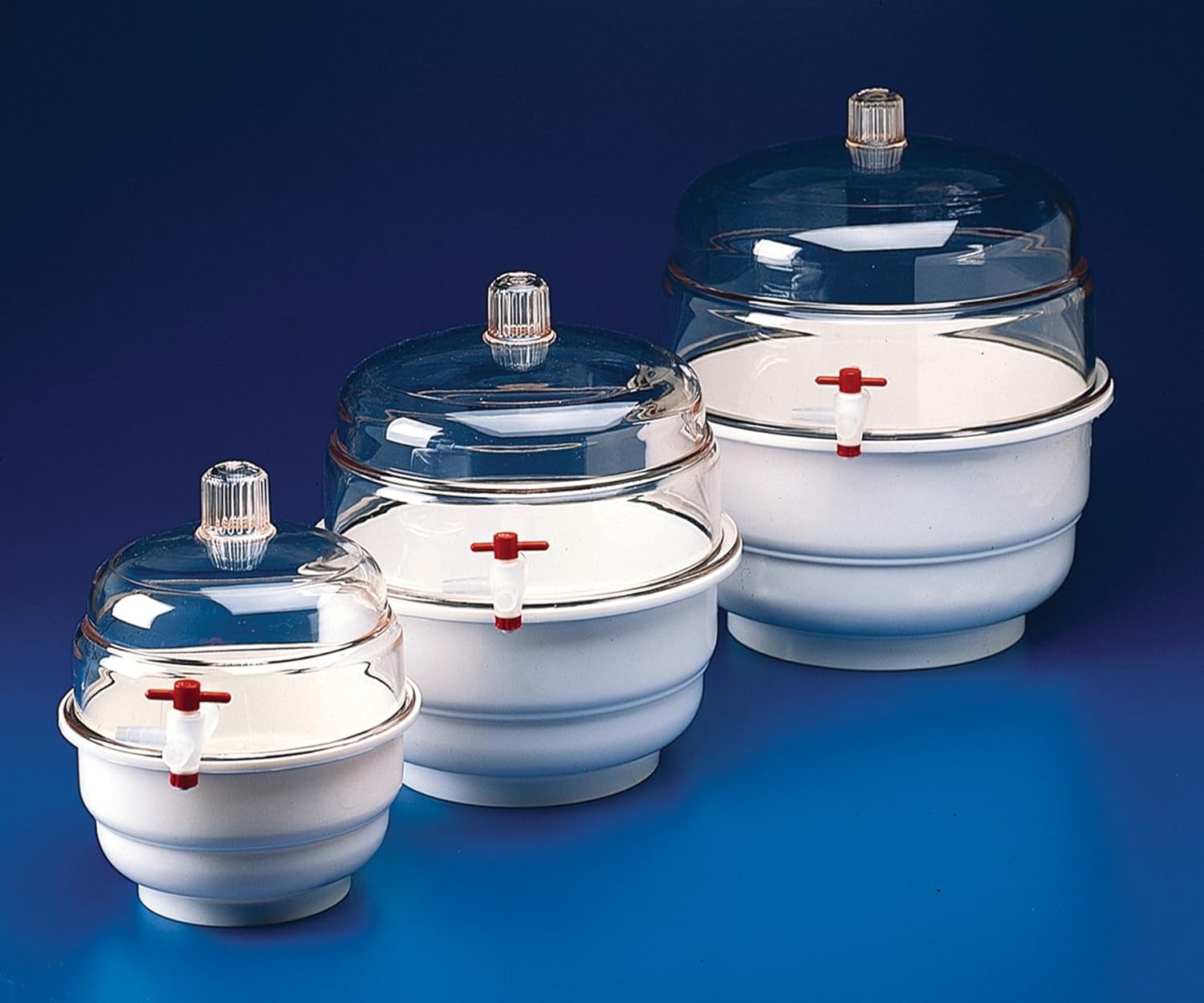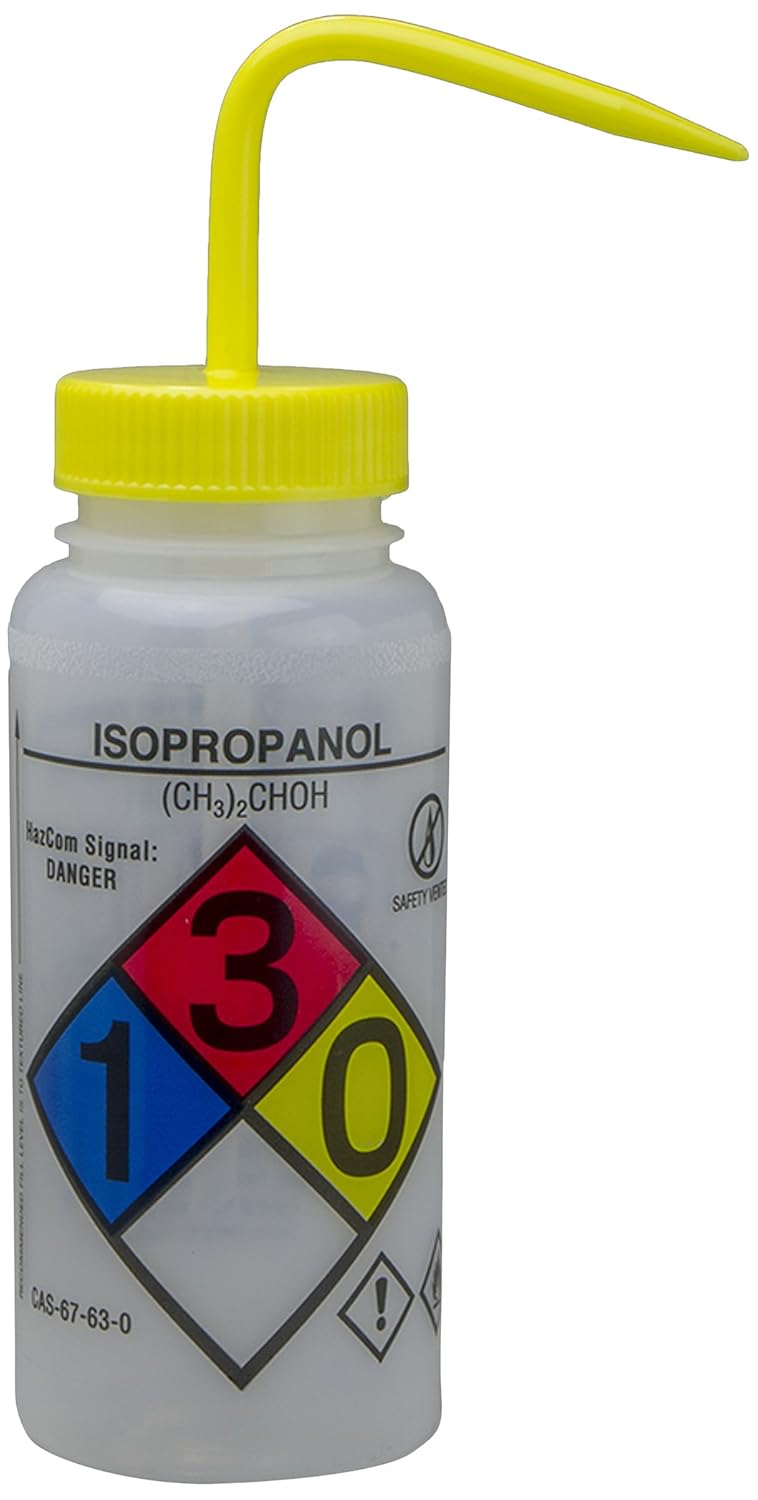SP Bel-Art “Space Saver” Polycarbonate Vacuum Desiccator with White Polypropylene Bottom; 0.09 cu. ft. (F42010-0000)
$191.07 $166.15
- Holds a full vacuum (29.9″ Hg 75.9cm) at room temperature for 24 hours; will remain airtight even if not under vacuum
- Polypropylene stopcock with PTFE plug accepts 6.4mm (¼”) I.D. tubing and allows a controlled entrance of air preventing unnecessary turbulence
- ‘Flat Dome,’ clear polycarbonate top with large ribbed knob maximizes interior clearances and provides an average of 13% greater interior volume over standard hemispherical domes
- All models include a 0.32 cm (⅛”) thick perforated plate; disposable or reusable desiccant can be placed on or under this plate
- Clear polycarbonate top on a bottom that is either clear polycarbonate or chemical-resistant white polypropylene


Desiccators
Desiccators are an economical and reliable way to assure dry, dust-free, and if necessary, air-free storage of humidity sensitive products, such as valuable reagents or electronics.
Depending upon what you are storing, optimal conditions can be achieved using standard desiccants in a manual or automated format, with gas purge or by keeping the contents under vacuum.
When choosing a desiccator the following questions should be considered:
Q. What storage environment is optimal or required?
A. Use this chart for an overview of the environment and benefits each method of desiccation provides.
| Standard Desiccant | Automated, Standard Desiccant | Gas Purge | Vacuum | |
|---|---|---|---|---|
| Manual monitoring and operation. Moisture is absorbed from air in the unit by using a desiccant. Once the desiccant is 'saturated' it must be regenerated through heating, or replaced. | Electric fans and heaters continuously regenerate the desiccant to prevent saturation and to automatically maintain a low humidity environment. | A slow steady flow of inert gas (often dry nitrogen) is provided. | Air and moisture are removed by the chamber by use of a vacuum pump. | |
| Flexibility to use any type of desiccant (silica gel beads, activated charcoal, etc) based on economics and convenience. | Convenience, requires minimal monitoring. | Achieve relative humidity at a much faster rate. | Best for total dry storage or if air could be damaging to material being stored. | |
| Portability. | Precise control of humidity. Operates on a set schedule of desiccation followed by a regeneration period. | Dust free and desirable for many applications including clean room environments. | Dust free and desirable for many applications including clean room environments. | |
| Economical functionality. Most desiccants can be regenerated periodically. | Process uses silica gel beads that last for thousands of regeneration cycles. | Option to close stopcocks and use with regular desiccants. | Option to close stopcocks and use with regular desiccants. |


What do you need to know to choose the right desiccator?
Q. What size(s) are the items you need to store and in what quantity?
A. Interior volume of the desiccator and shelving should be considered.
Q. How important are ease and economy of use?
A. Each method of desiccation has advantages and trade-offs. Each user must determine the method that best serves their purposes. Using standard desiccants and regenerating them as needed is economical, but requires monitoring. There may also be more variability in your environment. An automated desiccator requires much less monitoring but uses electric power. Gas ported desiccators are quick to achieve relative humidity, but if the unit is accessed frequently, proportionately more gas will be needed to keep the desired low humidity level. Vacuum desiccators remove air and moisture and can be brought back to vacuum rather easily after opening but require a pump.
Once you have determined your most desirable method of desiccation, there are a variety of styles and sizes of desiccators to choose from.
Search by brand name indicated below for more information.

|

|

|

|

|

|
|
|---|---|---|---|---|---|---|
|
Secador |
Space Saver |
Techni-Dome |
Dry-Keeper |
Lab Companion |
Scienceware |
|
| Standard Desiccation | 0.31 to 1.87ft³ | 0.09 to 0.31ft³ | 0.14, 0.35, 2.01 & 2.08ft³ | 0.21 & 3.6ft³ | ||
| Automated, Standard Desiccation | 0.51 to 1.87ft³ | 1.2, 2.01 & 2.08ft³ | 3.6ft³ | |||
| Gas Purge Desiccation | 0.31 to 1.87ft³ | 2.29ft³ | 0.14ft³ | 3.6ft³ | ||
| Vacuum Desiccation | 0.09 to 0.31ft³ | 2.29ft³ | 0.2, 0.4, 0.7, 0.8, 1.2 & 1.6ft³ | 0.015 & 0.21ft³ |

|

|

|

|

|

|
|
|---|---|---|---|---|---|---|
|
F42010-0000 |
F42012-0000 |
F42020-0000 |
F42022-0000 |
F42025-0000 |
F42027-0000 |
|
| Bottom Material | White Polypropylene | All-Clear Polycarbonate | White Polypropylene | All-Clear Polycarbonate | White Polypropylene | All-Clear Polycarbonate |
| Flange O.D. | 17.1cm (6¾") | 17.1cm (6¾") | 23cm (9¹/₁₆") | 23cm (9¹/₁₆") | 27.3cm (10¾") | 27.3cm (10¾") |
| I.D | 14.9cm (5⅞") | 14.9cm (5⅞") | 19.7cm (7¾") | 19.7cm (7¾") | 24cm (9⁷/₁₆") | 24cm (9⁷/₁₆") |
| Plate Diameter | 14cm No.3 | 14cm No.3 | 19cm No.4 | 19cm No.4 | 23cm No.5 | 23cm No.5 |
| Overall Height | 20.6cm (8⅛") | 20.6cm (8⅛") | 26cm (10¼") | 26cm (10¼") | 31.1cm (12⅛") | 31.1cm (12⅛") |
| Clearance above plate | 12.1cm (4¾") | 12.1cm (4¾") | 15.7cm (6³/₁₆") | 15.7cm (6³/₁₆") | 19.7cm (7¾") | 19.7cm (7¾") |
Product information |
|||||||||||||||||||||||||||||||||||
|
| Weight | 1.01 lbs |
|---|
Only logged in customers who have purchased this product may leave a review.
Related Products
BISS LAB Products
PEAK TS1962 Fixed Focus Loupe, 15X Magnification, 0.75″ Lens Diameter, 0.79″ Field View
BISS LAB Products
Talboys 916188 Stainless Steel Small Column Clamp, 65mm-89mm Holding Size, 282mm Overall Length














Reviews
There are no reviews yet.